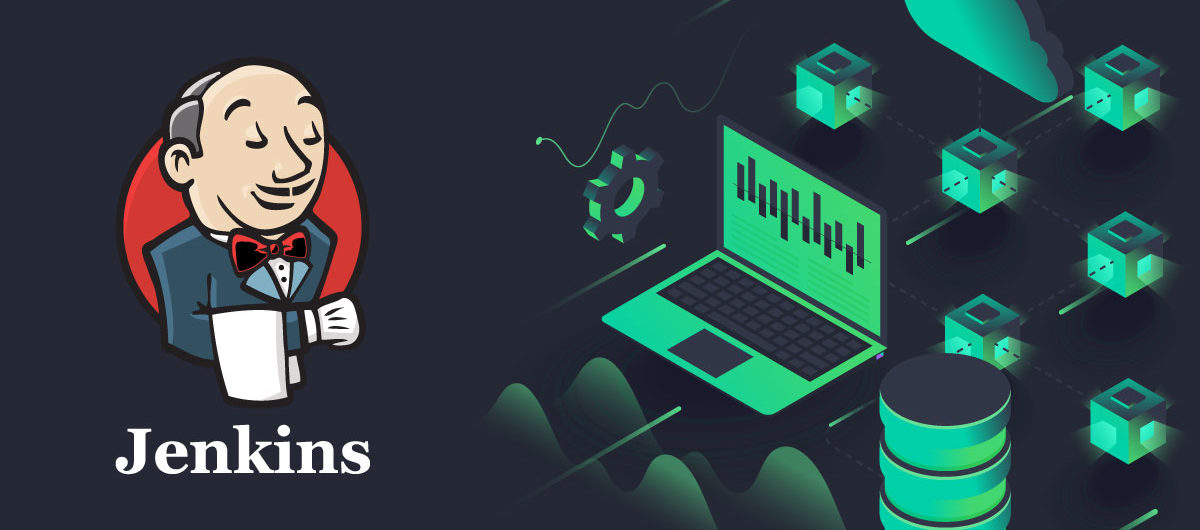The same applies to Git, which has become an essential component of DevOps setups today. Almost 90% of developers prefer Git as their version control or source code management system while executing large projects with multiple stakeholders. It provides an isolated environment to test every change in the codebase and helps to preserve the master branch.
Besides being an open source, lies in its distributed peer-to-peer model which is particularly suitable for projects with complex structures.
DBmaestro and Jenkins: A Potent Combo
Software development has come a long way in recent years and has become very agile, with most of the processes automated smoothly.
But when it comes to databases, even when deployments are done with tools like Jenkins, human intervention is still required. This introduces many pain points and bottlenecks. Matters get even more complicated when there is limited manpower and the time-to-market times need to be reduced. This is when corners are cut (i.e, – dry-runs, testing).
The CI industry projected to grow at more than 18% every year, something that should improve CI/CD processes and promote DevOps in general. Even though Jenkins may work well for basic database actions, it does not provide visibility into what happens in the database, nor does it help with risk mitigation, documentation, or version control.
This often translates to human error, painful rollbacks, configuration drifts, and overall frustration – all big DBA pain points. Delivering database changes with Jenkins is essentially blind automation – you will accelerate, but without seeing the potholes on the road or the wall that lies ahead. Database visibility is completely missing from this otherwise great product.
But there is a silver lining – Jenkins has over 1700 plugins that can help solve problems unique to a project. One can enhance productivity with plugins that take care of source code management, UI/UX, administration, building management, platforms, etc. Also, DBmaestro for Jenkins is a database DevOps automation platform that is helping eliminate many pain points.
DBmaestro’s plugin for Jenkins presents a solution to elegantly integrate and swiftly execute projects, while breaking down walls between your development and operations teams. This integration allows you to secure the process of adding database deployments into your CI/CD pipeline, while seamlessly syncing with your existing ecosystem.
The end result – you can instantly improve the deployment of incremental database changes, a key DevOps requirement. Furthermore, you can enforce best practices for the database, automate releases, mitigate downtime risk, and run audits for traceability and compliance. All company security, compliance, and operational policies become easier to enforce.
DBmaestro, when used in tandem with Jenkins, gives you:
- Automated database Devops
- Less release bottlenecks and errors
- Risk mitigation – Preventing bad code execution or overriding changes
- Saved time, money, and resources with automated procedures
- Better policy enforcement with user and role management
- Improved security and compliance standards
Thanks to the aforementioned benefits and advantages, you can accelerate your time to market with zero disruptions. The Database Administrator (DBA) can finally govern and automate database releases, while preventing the obscenely expensive downtime which can cause extensive operational and business damage (product launch delays, buggy releases, etc.).
Learn More About DBmaestro and Jenkins working together to Create Seamless Database DevOps
Achieving Zero Disruption
Moving towards zero disruption when introducing new processes is an important goal in any DevOps setup today, especially when it comes to database release management. That’s why your database automation solutions need to be agile and should be able to adapt to your existing processes and tools. Integration is the name of the game today.
With DBmaestro you can model a visual database pipeline, a first-of-its-kind in the industry, to steer clear of disruptions and downtimes. It allows you to build the release process and also a clear path to production while supporting seamless integration with all sources of database changes. The release process built with DBmaestro incorporates scripts created by the product, developers or third party tools, all with standard SQL coding.
Another hurdle, especially when working with multiple teams is security and governance. Defining roles, specifying access, and enforcing policies are all important steps when it comes to maintaining razor-sharp focus in extensive projects. With DBmaestro, implementing organizational policies, managing permissions, and meeting compliance regulations are all automated.
Also, it combines version management with pre-checks that can identify and prevent run-time issues, flag configuration drifts, and conflicts. By doing this you are preventing rogue code from running and revalidating the final state required to successfully end the process. You can also create custom project-specific policies while creating a detailed audit trail of all changes.
Besides the technical benefits mentioned above, you also stand to gain as a manager or a business owner. Faster development with zero disruption means that you can make informed executive decisions faster, measure the number of successful and failed deployments, the lead time, and the mean time to recovery, and establish the required KPIs for your database teams.
Related: Zero Downtime Database Deployment
Shortening Feedback Loops
While we are on the topic of pain points in database DevOps, here’s one that can cost you a fortune – Long feedback loops. In an increasingly dynamic market, continuous and shortened feedback is a great way to improve code quality. One of the major differentiation factors in modern DevOps is its ability to incorporate feedback to improve functionality and reliability.
Did You Know?
As per a recent OverOps survey, almost 50% of DevOps professionals claim manual processes are their biggest hurdle to their CI/CD goals.
With automated databases, actionable insights and performance metrics are available in real-time to improve the productivity of developers, DBAs, and IT professionals. This technical feedback loop is the driving force behind every smooth CI/CD pipeline and needs to be prioritized today.
The process followed by DBmaestro in this regard is particularly helpful.
- A developer deploying changes to your company’s software or database will create the code, run its versions, do regression and unit testing, build automation and commit to Git.
- Before those changes are implemented DBmaestro pulls them up and runs your pre-defined permission, policy, and run time checking. The dev team receives feedback about potential issues, if such arise.
- Completed tasks are moved to Jenkins via JIRA. Jenkins then commands DBmaestro to run its checks. For instance, if a developer has not named a table correctly it will pop an error message. In this case, the error may read “you can’t create a new table that doesn’t start with App_module_ followed by name”. The code is sent back to the first stage for remediation. This is how a short feedback loop looks like.
- Once the detected issues have to be fixed, the code is sent for a dry run where issues such as spelling errors and code rifts may crop up. An email is sent back to the dev team with the details of the issue.
- Only after the dry run is performed smoothly, the DBA can pull the trigger on the release and make sure that there are no issues or bottlenecks that can create disruptions or downtime.
To sum this up, the entire CI/CD pipeline can finally work as one unified entity, where feedback loops are shortened for faster development and improved quality. Also, fewer errors translate to enhanced productivity and engagement with the DevOps process. Because let us face it, it is tough and frustrating to go back to fixing code you deployed a month ago.
Related: Automated DevOps: The Key to Business Continuity
Why Are Short Feedback Loops Important?
Besides saving time and effort, short feedback loops help invest in quality and performance testing. Each customer is unique and will use your software in unpredictable ways making it impossible to not have undesirable performance implications. Even a small deployment can increase in your page load time or lead to 404 errors.
Once you have nullified your database deployment bottlenecks and downtime, you can invest in dry-runs and testing. This will elevate your product’s quality significantly. This also means less re-working of code (extra hours for developers), fewer post-release patching, and stability updates. This is great news for your brand and financial metrics.
Did You Know?
Downtimes cost anywhere from $5600 per minute to $300,000 per hour. This is before we dive into brand damage.
Shortened feedback loops allow the early diagnosis of code stability issues. DBmaestro helps you to check any code in an isolated environment and sends feedback to the DevOps team about its behavior. Not only are detection and remediation times reduced, you also avoid unfortunate bottlenecks when you approach the end of the CI/CD pipeline.
In cases where issues crop up outside of the testing environment, it provides accountability for each action through its comprehensive audits which allows you to trace who did what, when, and why. Every database action is automatically recorded and documented. This ensures effective rollouts of quality releases and software updates without disrupting user experience.
Real Life Example of an End-To-End CI/CD Pipeline
One of the largest transportation and information management companies operating out of New Zealand, recently got to use DBmaestro with Jenkins.
The dev teams now collect all script change tickets from Git, trigger the process with Azure DevOps, and let DBmaestro work it’s magic to look for potential issues that can cause problems at a later stage. DBmaestro essentially gets this package and initiates a CI pre-check process that evaluates security, policies, and dev errors like dropping of tables.
This CI process allows the smooth triggering of Continuous Deployment (CD), where cherry-picking is done when needed or the team simply reverts to nightly builds. Changes are seamlessly deployed to the database and also to Git for automated testing, prior to database release automation that is a part of your app release. Nothing is segmented. It’s all hooked together.
Continuous Delivery (CD) Comes Naturally
One you have your database Continuous Integration (CI) figured out, the Continuous Delivery (CD) aspect is simplified. The right time for CD is, literally anytime. It can be done instantly if an urgent release is required. In other setups, it can be triggered on a nightly or weekly basis. What’s important is that the version at the end of every sprint is tested, verified and good to go.
Partial DevOps will accelerate your proverbial sports bike for sure. You will feel the rush as the wind goes through your hair. But the wind will also hinder your vision and prevent you from seeing the potholes that can cause your bike to skid or hit a tree, whatever comes first. DBmaestro and Jenkins are like helmets and gloves. They’ll enhance your ride and help you win the race.
This setup addresses all the challenges DevOps teams face today – security, source control, delivery roadblocks, risk, and compliance. With early testing and validation, along with shortened feedback loops, disruptions and downtimes become things of the past. This is the only way to shorten your time-to-market without sacrificing quality and innovation. Get proactive now.





